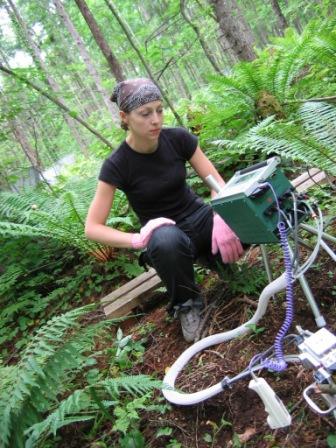 | [Effect of spatial variation of soil respiration rates following disturbance by timber harvest in a larch stand in northern Japan (Tomakomai, 2004)] |
|
|
Study site |
Li-Cor 6400 |
|
|
|
|
The present work was undertaken in a 50-year-old (in 2003) larch plantation located in Tomakomai National Forest (42o44''N, 141o31''E, altitude is 115-140 m a.s.1.) in Hokkaido, Japan. The tree cover at the site was predominantly Japanese larch (Larix kaempferi (Lam.) Carr.), interspersed with Japanese spruce (Picea jezoensis Sieb. et Zucc.) and mixed broadleaved species (birch, oak, magnolia etc.). The forest understory was mainly Dryopteris crassirhizoma Nakai., with Dryopteris expansa (C.Presl) Fraser-Jenk. & Jermy and Pachysandra tenttinalls Sieb. et Zucc. The site is characterized by a humid climate, with cold winters and cool summers. The mean annual precipitation at the site is approximately 1250 mm, and the mean annual temperature is 7.3oC, with a variation in the monthly mean value ranging from 19.1oC in August to -3.2oC in January. To examine the effects of thinning on soil respiration (Rs), we selected two sites. One of them as a control site (which had been thinned ca. 15 years ago) and another one adjacent to it is disturbed site (thinned in January 2004). The size of both control and disturbed sites was about 40 m x 40 m each, and they were adjoined to each other. To evaluate the soil CO2 flux of the larch plantation, we measured spatial variation of the Rs. We combined Rs measurements with measurements of temperature, mineral soil water content and other environmental variables to track the component fluxes of the Rs.





